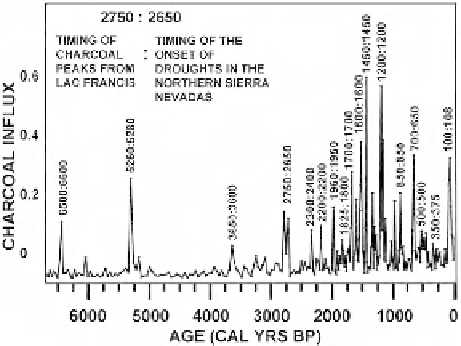Geoscience Reference
In-Depth Information
past. This hypothesis suggests that the northern Polar Front
and associated storms moved northward over central Green-
land at the beginning of moist conditions in Greenland.
Simultaneously, the northern subtropical high-pressure zone
moved northward over the northern Sierra Nevada bringing
severe drought conditions to the northern Sierra Nevada. The
opposite precipitation scenario would be true, when the
northern Polar Front moved southward away from central
Greenland and over the northern Sierra Nevada, the subtrop-
ical high-pressure zone would have moved southward away
from the northern Sierra Nevada. The shift in these major
precipitation belts may have been abrupt.
5.3. Soot and Charcoal Deposition Records From Eastern
Canada and Greenland
Figure 11.
Correlation between the timing of the beginning of
droughts in the northern Sierra Nevada and charcoal peaks from Lac
Francis, Quebec. The timings for the 14 largest charcoal peaks from
Lac Francis over the past 6750 years (adapted from Carcaillet et al.
[2001]) were compared with the starting dates for 14 severe droughts
in northern Sierra Nevada over the same time interval [Mensing et
al., 2004]. Vertical numbers above charcoal peaks represent the
timing of charcoal peaks from Lac Francis relative to the timing of
the onset of droughts in the northern Sierra Nevada.
I compared the 8500 year long Coburn Lake charcoal
record with a biomass burning record from the GISP2 ice
cores from central Greenland [Taylor et al., 1997; NSIDC
and WDC-A, 1997]. More than 90% of Coburn Lake char-
coal peaks coincided with peaks in soot from Greenland ice
cores (Figure 10). Both records also displayed greatest de-
position of either charcoal or soot during four time periods:
(1) before 7800 years ago, at around the time of the 8200
event; (2) at 5800
5000 years ago, during the wet period that
followed the Altithermal, which was ended by the 5200 year
event; (3) at 3000 years ago; and (4) after 2000 years ago as
Greenland, and presumably the Sierra Nevada, became
colder and wetter and precipitation patterns, as described in
section 5.4 below, became more unstable.
ThesootintheGISP2icecoreisbelievedtohave
originated from forest fires that burned in eastern Canada
[Taylor et al., 1996]. Lac Francis is located in eastern
Canada. A charcoal record from Lac Francis developed by
Carcaillet et al. [2001] goes back to approximately 6750
years ago. Interestingly, the timing of the beginnings of
severe droughts in the Sierra Nevada [Mensing et al.,
2004], and thus peak charcoal deposition into Coburn Lake,
was signi
-
5.4. Increase in the Frequency of ACCEs During the
Late Holocene
In terms of temperature, both Greenland and the Sierra
Nevada became cooler during the Late Holocene. In Green-
land, the magnitude of fluctuations in temperature increased
markedly after approximately 3700 years ago, and long-
term cooling began approximately 2400 years ago. Cooling
in Greenland accelerated at approximately 1000 years ago
[Meese et al., 1994; NSIDC and WDC-A, 1997] (Figure 12).
In the Sierra Nevada, Clark et al. [2002] noted that long-
term cooling began by 3400 years ago.
Both Greenland and the Sierra Nevada experienced in-
creased precipitation and more erratic precipitation during
the late Holocene. In Greenland, the size or magnitude of
fluctuations in precipitation increased substantially after ap-
proximately 3000 years ago, and total precipitation increased
markedly after approximately 1300 years ago [Meese et al.,
1994; NSIDC and WDC-A, 1997]. In the Sierra Nevada, the
number of abrupt changes in precipitation increased some-
time between 3400 and 2700 years ago (Figure 5). Unfortu-
nately, an unintentional gap exists between core sections in
the Pyramid Lake record that covers this time period. There-
fore, the timing of an increase in the number of abrupt
changes in precipitation in the northern Sierra Nevada cannot
be further constrained at the moment. Precipitation did
cantly correlated (Pearson product moment cor-
relation coef
cient is 0.999) with the timing of deposition
of the largest charcoal peaks into Lac Francis over the past
2800 years [Carcaillet et al., 2001] (Figure 11). Other large
charcoal peaks from Lac Francis appear to correspond to
severe droughts in the northern Sierra Nevada that began at
approximately 6500, 5200, and 3600 years ago. Though the
climates of high elevation subalpine Coburn Lake and high
latitude boreal Lac Francis share some similarities today, it
is surprising to see such high correlations between two
records separated by a distance of almost 5000 km. These
results suggest that some ACCEs may have affected loca-
tions separated by very large distances.










Search WWH ::

Custom Search